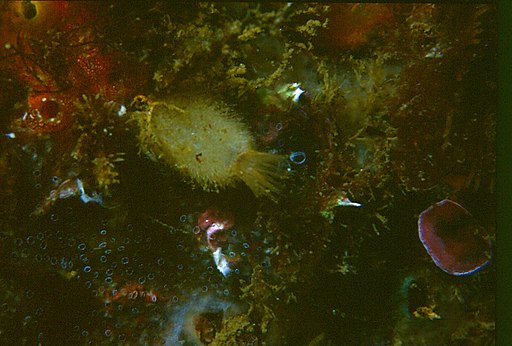Pineapple Sponges: Benefits vs Removal in a Reef Tank
Posted by on 03/10/2023
Pineapple sponges are a genus of filter-feeding animals that descend from calcareous sponges , multicellular animals that first appeared on our planet 450 million years ago. While some sea sponges can grow to be quite large, Sycon sponges, the name of the genus of sponges found in reef tanks, are quite small, growing only to about 7.5 cm in length.
In many cases, pineapple sponges are accidentally introduced into an aquarium as hitchhikers growing on small pieces of coral, rock, or macroalgae. While the sight of them may cause alarm for some hobbyists, whether or not you should keep or remove them is a controversial topic. In this post, we'll summarize the benefits of keeping and removing pineapple sponges, and we'll also discuss appropriate methods for their removal.
January's Giveaways on Light Fish
Pineapple Sponges
Over 50 different species of Sycon sponges exist, and identifying the differences between species is a difficult endeavor. Environmental factors, water current, and lighting, all play a role in the appearance of these sponges . Sponges are made up of spicules, and these spicules can be either calcareous or siliceous . Silicate-based sponges are known as Glass sponges and are uncommon in the world's oceans. They're seen far below the ocean's surface, at depths between 1500-300 feet, primarily in the waters of the Northern Pacific and Antarctica.
In the aquarium hobby, the species of sponges we encounter are made up of calcium-based spicules. They have a much larger distribution in the wild and can be found in shallow waters in a wide variety of temperate regions. Due to their distribution and the water conditions from which they're found, it's not surprising that they frequently appear in at-home aquariums.

Benefits of Keeping Pineapple Sponges
As filter feeders, many consider pineapple sponges a natural part of a reef aquarium.
Marine sponges grow utilizing water flowing through their small holes, called incurrent pores . By filtering the water passing through their bodies, sponges extract nutrients and other particles, which are then expelled through their excurrent pores. This purification process is why many hobbyists choose to keep pineapple sponges.
Pineapple sponges prefer low-light environments and often appear in shaded areas of a tank or a sump. If they begin to grow in high-light environments, they are often short-lived, as algae will usually cover them, restricting their ability to filter feed.
Benefits of Removal
It's important to keep in mind that pineapple sponges tend to self-regulate. While their population size may increase for a short period, soon after you'll likely begin to see some die-off, a process similarly seen with diatoms.
However, If you're a reef aquarium purist, then you may want to remove pineapple sponges strictly for your tank aesthetic. While they tend to hang out in shaded environments, many hobbyists are very particular about the appearance of their tanks.
Since sponges are living organisms, they will also compete with other living organisms in your tank for nutrients. They are capable of growing into large colonies, and in some instances, they may completely cover a coral and kill it. The shaded environments provided by corals such as blastos and chalices are prime real estate for a sponge population to grow.
Pineapple sponges prefer areas of low light and aquarium equipment such as powerheads, filters, sumps, and refugiums, are all common locations where pineapple sponges appear. If there are a large number of sponges, they may block water current, and reduce the efficiency of any powerheads or filtration methods you're using.
If you've decided that removing pineapple sponges outweighs the benefits they provide, you can utilize the following removal methods.
Removal Methods
The best removal method for pineapple sponges is manual removal. Using a pair of tweezers or a credit card, you can scrape at the base of the sponges and then remove them from a tank manually. If possible, removal will be a bit easier if you can remove whatever they're attached to before scraping them.
There is speculation that angelfish, certain nudibranch species, and spot-treating the pineapple sponges with vinegar may result in their removal, but your mileage may vary with these approaches.
The problem with pineapple sponge removal methods is that dozens of species comprise the genus, and many have matching appearances.
While some hobbyists may report a nudibranch successfully munching on their sponges, others may experience different results. In most cases, the cause is often because the sponge in their tank is a different species, even though it's visually indistinguishable.
Hopefully, in the future, more research and tests will be performed so that we can learn more about these species of sponges. For now, manual removal remains the best approach.
Prevention Tips
The best way to avoid pineapple sponges from appearing in your aquarium is to prevent them from being introduced in the first place.
Always carefully examine anything you plan on adding to your display tank. It's always best practice to quarantine any new tank additions for a 2-3 week period.
In many cases, you'll be able to lessen the chances that pineapple sponges will appear by manual inspection.
Due to their small size, it may be inevitable that you'll encounter pineapple sponges in your reef-keeping career, but having a prevention plan is always a smart decision.
Conclusion
Choosing whether or not to remove pineapple sponges from a saltwater aquarium largely comes down to individual preference. The presence of these life forms can indicate a healthy ecosystem, but some hobbyists may consider their appearance to be undesirable.
Now that we've covered the fundamentals, do you plan on removing them from your tank? Let us know by commenting below, and be sure to visit our marketplace and community forum, where you can buy, sell, and discuss everything related to reef keeping with other hobbyists.
January's Giveaways on Light Fish


